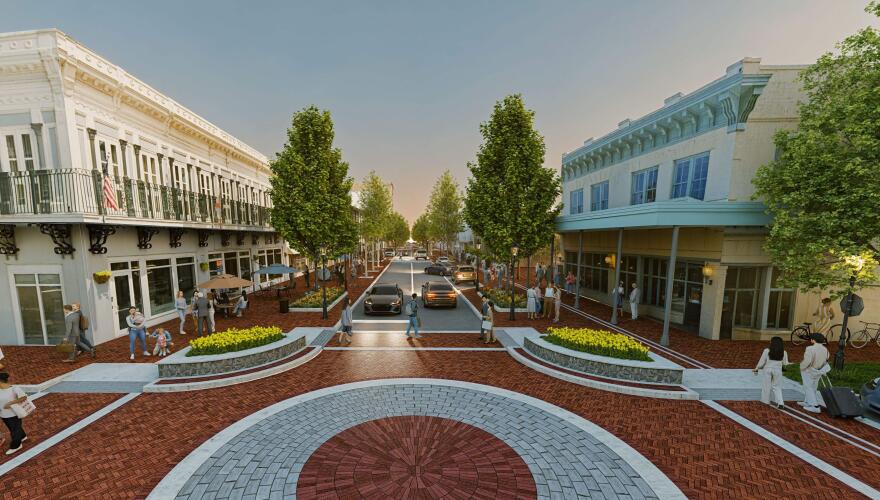Pensacola’s plan to remake a key stretch of Palafox Street is heading toward a final decision this week, as the Community Redevelopment Agency and City Council prepare to vote on funding and the formal award of a construction contract that could launch work in early January. City officials say the project will fix chronic drainage issues, improve accessibility, and make the downtown corridor safer for pedestrians and cyclists. But many business owners warn the accelerated construction timeline and full street closure could threaten their livelihoods during crucial retail months.
The project consolidates pavement restoration already required after Florida Power & Light’s undergrounding work with long-planned safety and stormwater improvements. Mayor D.C. Reeves said at a Nov. 4 briefing that repaving only the utility cuts would force the city to “come back and tear up the same street twice,” leaving flooding and accessibility challenges unaddressed. By completing the broader rebuild now, he said, the city can deliver a corridor that addresses long-standing flooding and accessibility issues that a simple repaving would leave unresolved.
Council action this week
The City Council is slated to take two significant votes. Tonight, the CRA will consider reallocating Urban Core bond funds, CRA dollars and a utility contribution to fully finance the project. Later in the week, the full council will vote on awarding a contract for the work to Site and Utility, LLC, the contractor recommended by staff.
The bid includes a $7.69 million base bid, along with a 10% contingency and an early-completion incentive pool worth up to $768,794.25. The total project authorization before the council is $9.23 million, according to the agenda materials.
If approved, construction would bring a full closure of South Palafox between Garden and Main streets during the most intensive phase of work.
What the project includes
The plan calls for installing roughly 1,700 linear feet of storm pipe and adding storage for about 93,000 gallons of stormwater. More than 40 Americans with Disabilities Act upgrades are included, along with raised intersections and textured pavers intended to slow traffic and clarify that the roadway is shared among drivers, cyclists and pedestrians.
City staff say some aesthetic elements were pared back during design review to keep the project within budget. The remaining features prioritize flood control, safety and accessibility. Throughout construction, sidewalks would remain open, with fencing, lighting and signage guiding customers to businesses.
Timeline and incentives
Construction is scheduled to begin in early January under an accelerated 24/7 schedule. The contract includes two tiers of early-completion incentives: a 10% bonus for finishing by May 24, and a smaller bonus for completion by mid-June. After July 4, liquidated damages of $1,000 per day would apply.
Reeves has said the incentive structure is designed to minimize disruption for businesses. If the contractor fails to earn the bonus, the mayor has proposed redirecting the unused incentive dollars to a Downtown Improvement Board program that would provide rent or business-interruption relief.
The mayor has also called on private property owners to shoulder part of the burden. In a letter sent last month, Reeves asked landlords to provide at least $10,000 in temporary rent reductions per commercial tenant from January through May. Those who contribute $25,000 or more would be recognized as project sponsors and commemorated along Palafox. Reeves also urged private parking-lot owners to offer free or discounted spaces during construction.
Business concerns
Downtown merchants say they support improving Palafox Street but argue that the current execution plan threatens small retailers and restaurants. In a letter to the City and CRA, they warned that the construction approach “poses a serious threat to the survival of small, locally owned businesses.”
They wrote that extending the project to 26 weeks—with only a “modest 10% incentive” for early completion—creates “significant uncertainty about the project’s true timeline” and could leave merchants bearing the risk of prolonged disruption.
The group said a six‑month period of noise, closures and restricted access “will be devastating to local merchants who have long struggled with a lack of downtown foot traffic,” adding that the loss of adjacent parking and loading zones risks “shuttering longstanding businesses and eroding the local character of the historic Palafox Street.”
Parking remains their central concern. The letter notes that merchants “received only one complaint about pedestrian access but more than twenty regarding parking,” underscoring what they described as the most pressing daily challenge.
The merchants urged the City and CRA to slow down, “pause, revisit, and revise the current construction approach—prioritizing mitigation of business impact and meaningful input from those whose livelihoods depend on downtown’s continued accessibility and vitality."
What happens next
The CRA will take up the funding reallocation at its meeting tonight. If approved, the full City Council will vote later in the week on the construction contract and associated budget measures. That would allow the city to sign the contract and begin preparations for a January start.
Reeves said the goal is to complete the project before the summer tourism season, when downtown typically sees its highest foot traffic.


